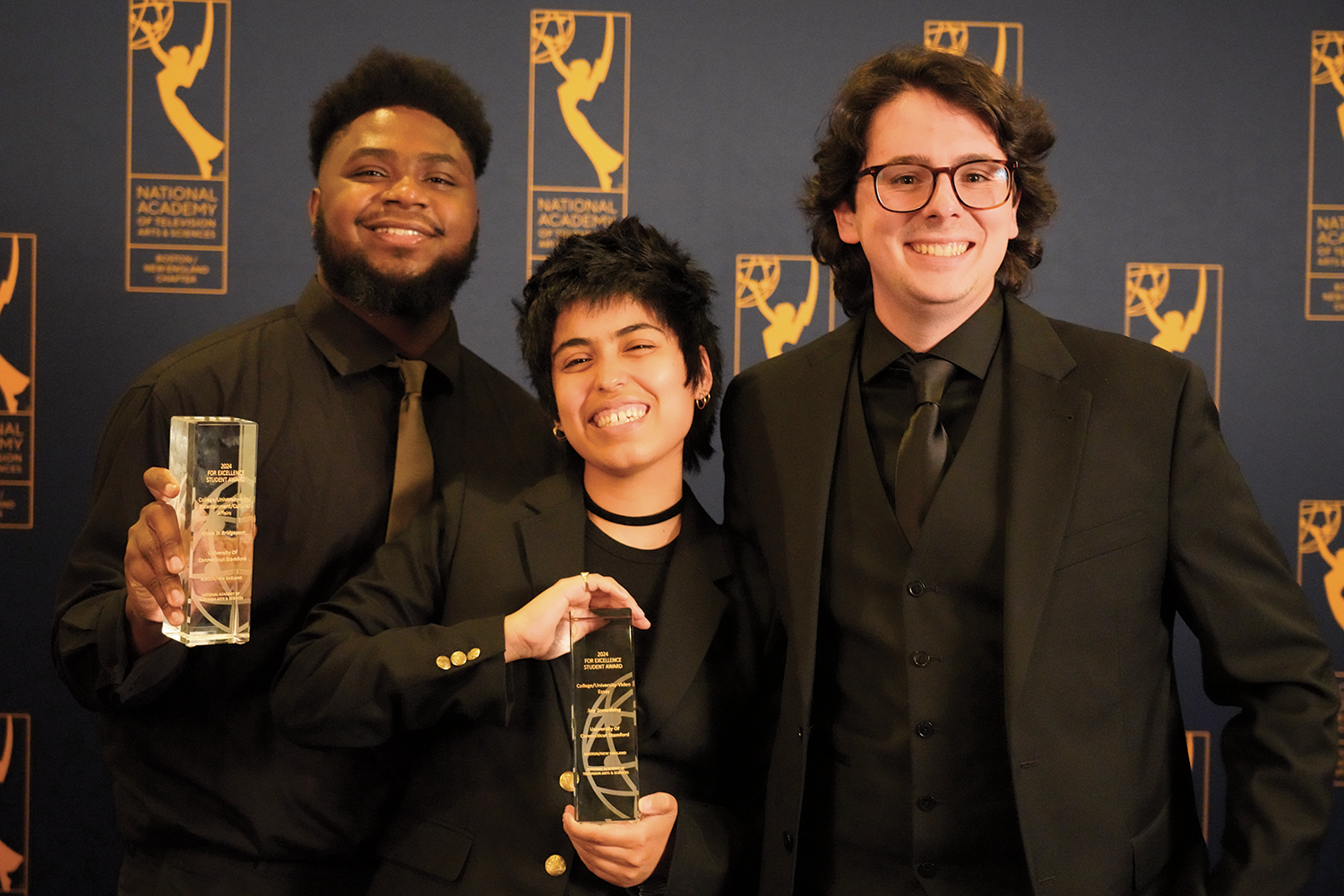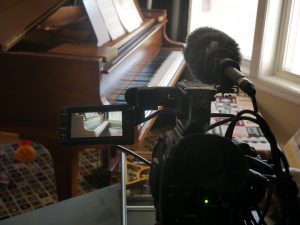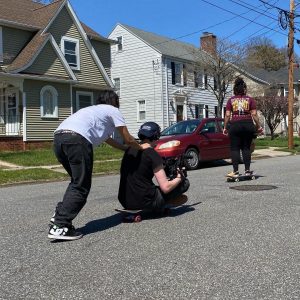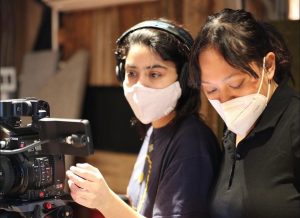Get Personal
Film what you know and embrace the vulnerability, advises this Emmy-winning filmmaker-professor, whose students now have Emmys themselves

Jayvell Gray '23 (SFA), Agustina Aranda '23 (SFA), and Christopher Orrico '23 (SFA) at the 47th Boston/New England Emmy Awards Gala in June.
When the undergraduate seniors studying in UConn Stamford's digital film and video production concentration start preparing for their capstone projects, their professor advises them to go personal.
"When they pitch me an idea, and they say, 'Oh, I want to do the next Marvel movie,' I'm like, man, you have no budget," Emmy award"“winning documentary filmmaker Oscar Guerra tells his students.
"But use the capital you have. And the capital you have is telling your own story."
It's a challenge to share your own story — it means you have to be vulnerable. And along the way you'll undoubtedly be critiqued — by your professor, by your peers, and by your audiences, something made all the more difficult by that oh-so-personal investment in the story.
But it's also an opportunity, says Guerra, for a young filmmaker to write their own narrative.
And to learn a valuable lesson about trust — trust in your mentors; trust in those working alongside you; and trust that, when you tell a great story, it will resonate.
It might even resonate enough for a bevy of wins at the 47th Boston/New England Emmy Awards Gala.

UConn launched its digital film and video production concentration through the Digital Media and Design (DMD) program at UConn Storrs and UConn Stamford in 2019. The first UConn Stamford cohort — Agustina Aranda '23 (SFA), Christopher Orrico '23 (SFA), Jayvell Gray '23 (SFA), Shannon Nasution '23 (SFA), and Yazmine Uvidia '23 (SFA) — also are the first students to have their work distributed through UConn Reels, a new collaboration between DMD and Connecticut Public.
"PBS Connecticut was really committed to finding ways to work with us," says Guerra, who's produced multiple documentaries for PBS's "Frontline" and worked to start discussions with the network to find ways to collaborate. "They really liked the idea, because it's not just that they want content, they want good content. So it was just a matter of everyone getting connected to see the type of work that we're doing."
Guerra's students ultimately produced five short documentaries, which were published online and aired on PBS broadcast channels through UConn Reels. These largely Connecticut-centric stories included a profile of the local indie-pop band Similar Kind; an examination of the once-thriving, now-waning skateboard culture in Bridgeport; and a glimpse into the innovative Bridgeport fashion scene pioneered by Black and Brown designers, models, and promoters.
The students also shared their personal stories — the ones where they had to be vulnerable and allow themselves to be present in the work. For Aranda and Orrico, those came through vastly different portraits of their fathers.

Christopher Orrico's short film "The Ladder" takes a look at events that helped shape his father's life and shares the lessons of that life that are now being passed on to new generations of his family.

Students collaborated on the short film "Public Hazard," which examines the once-thriving, now-waning skateboard culture in Bridgeport, Connecticut.

Two members of the collaborative first cohort of film production students at UConn Stamford — Agustina Aranda (left) and Shannon Nasution.
Aranda's "Say Something" offers an intensely intimate look at the de-evolution of a father-daughter relationship portrayed through interview, archival footage, and animation. For Orrico, "The Ladder" explains the events that helped shape his own father's life and shares the lessons of that life that are now being passed on to new generations within their family. Both say their willingness to share such personal aspects of their lives was made easier by the relationships they'd developed with their teachers and classmates. "I think being vulnerable came kind of easy," Aranda says, "because I knew these guys for my entire college career, and I knew the guidance they'd given me and would give me if I wanted to do this."
"We're friends at this point," agrees Orrico. "We had built this relationship, and we knew what each of us was good at. In terms of Agustina and myself, she was like, 'I'll direct something and you film it.' And I'm there for it. I know my strengths. I know her strengths. And it's just really important to trust. Sometimes, working with other people, it can make or break something. So trust was very much the biggest thing."
"The way that these particular students who are featured through UConn Reels were able to work together and work collaboratively on realizing these films is a real testament to the kind of community we create within the department, and to some of the uniqueness of the Stamford campus in particular," says Heather Elliott-Famularo, an award-winning filmmaker and head of DMD.

At the Boston/New England Emmy Awards Gala on June 8, Aranda won two Pillar Awards, the equivalent of a student regional Emmy, taking the College/University "“ Video Essay category for "Say Something" and the College/University "“ Arts/Entertainment/Cultural Affairs category for "Made in Bridgeport."
Orrico was recognized with an Honorable Mention in the College/University "“ Video Essay category for "The Ladder."
Aranda also won Best Documentary 2022 at the Bridgeport Film Festival for "Public Hazard" and the Student Documentary Award of Excellence at the BEA Festival of Media Arts 2024 for "Made in Bridgeport," and she premiered "Say Something" at the Slamdance 2024 film festival.
"It's always cool to accomplish something and feel proud of something and move forward with your work when you're so young, because it feels like you're on the right track," says Aranda. "As a student, I think it's just an extra layer of accomplishment. I did it, and I'm just a student. Imagine what I could do when I've done it for a while." It was also, Aranda says, an acknowledgment of her identity — something critically important to her and deeply apparent in all her work.
"I'm a Paraguayan American multimedia artist and filmmaker from Bridgeport, Connecticut," she says. "All these layers, that's all me, and every single layer comes into every moment of my work. That could be good or bad, because it's the way I navigate the world and a way that other people don't navigate the world. So all of these proud and public acknowledgments of my work, its extra special for me, personally."
It's also special for Guerra and for the program he, ÂElliott-Famularo, and their colleagues are nurturing in Stamford — a young program, not even technically its own major at UConn, that's already competing with larger, more established film programs in the Northeast region.
"A night like that one was a night of a lot of satisfaction and a lot of pride, to see them thrive," says Guerra. "And also for us, as educators, to know that what we do has some impact.
"Sometimes you don't get to see that at all. And that's what we do as educators — you plant a seed that you're not going to get to see grow. But on some rare occasions, like this, you do actually get to see it bloom."
By Jaclyn Severance


Leave a Reply